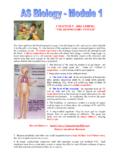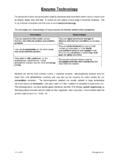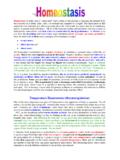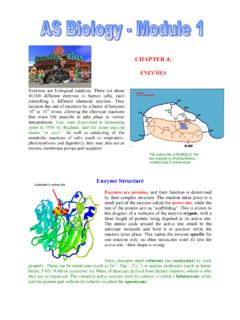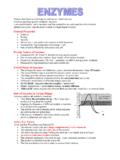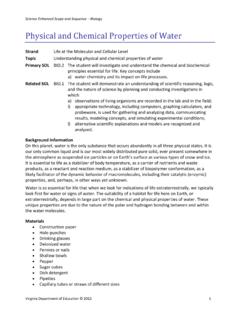Transcription of INTRODUCTION TO THE CELL - BiologyMad A …
1 CHAPTER 1: STRUCTURE AND FUNCTION. OF THE CELL. INTRODUCTION TO THE CELL. Both living and non-living things are composed of molecules made from chemical elements such as Carbon, Hydrogen, Oxygen, and Nitrogen. The organization of these molecules into cells is one feature that distinguishes living things from all other matter. The cell is the smallest unit of matter that can carry on all the processes of life. 1. Every living thing - from the tiniest bacterium to the largest whale - is made of one or more cells . 2. Before the C17th, no one knew that cells existed, since they are too small to be seen with the naked eye.
2 The invention of the microscope enabled Robert Hooke, (1665) and Anton van Leuwenhoek (1675) to see and draw the first cells ', a word coined by Hooke to describe the cells in a thin slice of cork, which reminded him of the rooms where monks lived. 3. The idea that all living things are made of cells was put forward in about 1840 and in 1855 came Cell Theory' cells only come from other cells ' contradicting the earlier theory of Spontaneous Generation'. Cell Theory consists of three principles: a. All living things are composed of one or more cells .
3 B. cells are the basic units of structure and function in an organism. c. cells come only from the replication of existing cells . CELL DIVERSITY. Not all cells are alike. Even cells within the same organism show enormous diversity in size, shape, and internal organization. Your body contains around 1013 to 1014 cells of around 300 different cell types, which we broadly classify into 4 groups. CELL SIZE. 1. A few types of cells are large enough to be seen by the unaided eye. The human egg (ovum) is the largest cell in the body, and can (just) be seen without the aid of a microscope.
4 2. Most cells are small for two main reasons: a). The cell's nucleus can only control a certain volume of active cytoplasm. b). cells are limited in size by their surface area to volume ratio. A group of small cells has a relatively larger surface area than a single large cell of the same volume. This is important because the nutrients, oxygen, and other materials a cell requires must enter through it surface. As a cell grows larger at some point its surface area becomes too small to allow these materials to enter the cell quickly enough to meet the cell's need.
5 (= Fick's Law something you need to learn well). Rate of diffusion Surface Area x Concentration Difference Distance CELL SHAPE. cells come in a variety of shapes depending on their function:- The neurones from your toes to your head are long and thin;. Blood cells are rounded disks, so that they can flow smoothly. INTERNAL ORGANIZATION. 1. cells contain a variety of internal structures called organelles. 2. An organelle is a cell component that performs a specific function in that cell. 3. Just as the organs of a multicellular organism carry out the organism's life functions, the organelles of a cell maintain the life of the cell.
6 4. There are many different cells ; however, there are certain features common to all cells . 5. The entire cell is surrounded by a thin cell membrane. All membranes have the same thickness and basic structure. 6. Organelles often have their own membranes too once again, these membranes have a similar structure. 7. The nucleus, mitochondria and chloroplasts all have double membranes, more correctly called envelopes. 8. Because membranes are fluid mosaics, the molecules making them up phospholipids and proteins - move independently.
7 The proteins appear to float' in the phospholipids bilayer and thus membranes can thus be used to transport molecules within the cell endoplasmic reticulum. 9. Proteins in the membrane can be used to transport substances across the membrane by facilitated diffusion or by active transport. 10. The proteins on the outside of cell membranes identify us as unique. Prokaryotes v. Eukaryotes Organisms whose cells normally contain a nucleus are called Eukaryotes; those (generally smaller). organisms whose cells lack a nucleus and have no membrane-bound organelles are known as Prokaryotes.
8 A Prokaryotic cell (bacterium) A Eukaryotic cell (plant). Prokaryotes Eukaryotes Typical organisms bacteria Protoctista, fungi, plants, animals ~ 10-100 m (sperm cells ) apart from the tail, are Typical size ~ 1-10 m smaller). Nuclear body Type of nucleus real nucleus with nuclear envelope No nucleus linear molecules (chromosomes) with histone DNA circular (ccc DNA). proteins Ribosomes 70S 80S. Cytoplasmatic very few structures highly structured by membranes and a cytoskeleton structure Flagellae/cilia made of Cell movement flagellae and cilia made of tubulin flagellin Mitochondria none 1 - 100 (though RBC's have none).
9 Chloroplasts none in algae and plants single cells , colonies, higher multicellular Organization usually single cells organisms with specialized cells Binary fission Mitosis (normal cell replication). Cell division (simple division) Meiosis (gamete production). PARTS OF THE EUKARYOTIC CELL. The structures that make up a Eukaryotic cell are determined by the specific functions carried out by the cell. Thus, there is no typical Eukaryotic cell. Nevertheless, Eukaryotic cells generally have three main components: A cell membrane, a nucleus, and a variety of other organelles.
10 THE CELL MEMBRANE. 1. A cell cannot survive if it is totally isolated from its environment. The cell membrane is a complex barrier separating every cell from its external environment. 2. This "Selectively Permeable" membrane regulates what passes into and out of the cell. 3. The cell membrane is a fluid mosaic of proteins floating in a phospholipid bilayer. 4. The cell membrane functions like a gate, controlling which molecules can enter and leave the cell. 5. The cell membrane controls which substances pass into and out of the cell.
